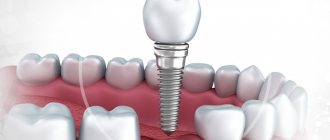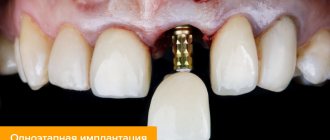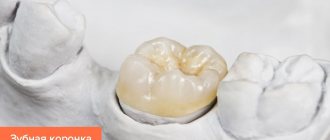A crown fell out: what to do before seeing a doctor
So, the crown came off. You can’t immediately grab any technical glue you have at hand and try to glue it back. Some people make a big mistake using superglue. Its composition is very toxic and burns through living tissue. The dentist will not be able to reinstall a crown fixed in this way.
If a crown comes off, follow these recommendations.
- Wash the fallen crown with water, wrap it in a napkin and place it in a bottle or box so that it does not break before your visit to the dentist.
- Brush your teeth gently. Be careful not to damage the stump. Use rinse aid.
- Hold off on eating and drinking drinks (except water).
- Make an appointment with an orthopedic dentist as soon as possible.
- If pain occurs, take a pain reliever.
How to glue a fallen crown at home?
If it is not possible to visit the dentist in the near future, the fallen denture can be temporarily glued back. Pharmacies sell dental cement, which is used to secure a fallen-off denture.
- Mix the glue ingredients according to the instructions.
- Apply cement to the washed and dried crown.
- Put it on carefully. If the denture does not fit easily into place, do not try to force it in to avoid chipping the tooth.
- Press the crown onto the tooth with your fingers for 1 minute (without being too hard).
- Then close your teeth for 2 minutes.
- Remove remaining cement with a toothpick or dental floss.
This way you will protect the tooth stump from bacteria and damage while eating before going to the dental clinic. Avoid solid foods, brush your teeth twice a day, and use mouthwash. However, dental cement should only be used as a last resort. Don't delay your visit to the dentist.
What determines the service life?
On average, a crown can last 5-7 years, and a dental bridge - 7-11. No one can give accurate forecasts; this is influenced by many factors.
The main ones:
- Materials used for manufacturing. The most durable structures are made of metal, but they have one drawback - an unattractive appearance. Metal-ceramic crowns are a kind of compromise between aesthetics and durability. There are other raw materials, each of which has its own advantages and disadvantages. However, when restoring anterior teeth, ceramics are the best option.
- Specialist qualification. Precision manufacturing and correct installation play an important role. Only then does saliva and food not get under the prosthesis, the gums do not become inflamed, and the product itself fits without gaps or voids.
- Fixation method. Crowns based on zirconium dioxide and metal-ceramics are attached to a special material – “cement”. Over time, it deteriorates, causing a leak. Structures based on lithium disilicate are fixed using a special technique, which ensures a strong connection and extends service life.
- Care and daily hygiene. It is necessary to brush your teeth 2 times a day. For a more thorough cleaning, it is better to floss and rinse your mouth after every meal. It is recommended to have your teeth professionally cleaned by your dentist periodically.
- Condition of the tooth. Often patients come when it has already been destroyed to the level of the gum or below. This does not allow the structure to be completely sealed, which means it will not last long.
As we see, durability depends on many factors, but the experience and qualifications of a specialist and the correctly selected method of restoring lost units play a big role.
Is it possible to put the old crown back?
Sometimes the doctor can replace the fallen crown in its original place. However, treatment tactics depend on the integrity of the prosthesis itself, the type of stump (pin, inlay, implant) and the degree of tooth destruction.
What to do if a temporary crown falls out
Temporary crowns are installed to protect the stump during the production of a permanent prosthesis. They are attached to temporary cement, which is gradually washed away under the influence of saliva. If a temporary plastic or ceramic crown falls out, contact your dentist to have it reinstalled. If this is not done and minimal damage appears on the stump, the permanent crown will not fit tightly and will quickly fall off.
The crown fell out, the tooth is intact
If the patient immediately consults a doctor and there is no caries on the tooth, the cost of installing a fallen crown will be minimal. The doctor will clean the stump and prosthesis from residual cement, and put the old crown in place. Small chips on the prosthesis are polished. If the damage is significant, a new crown is made.
What to do if a dental crown keeps falling out
If the crown falls off more than once, perhaps its size/shape does not match the stump or the installed pin is movable. Contact your dentist at the First Family Clinic of St. Petersburg. An experienced doctor will determine the cause of the prosthesis falling out and make the appropriate correction: in the first case, he will make a new crown, in the second, he will strengthen the support or install an inlay.
The crown fell out along with the tooth
If the tooth breaks off along with the prosthesis, but the roots are not damaged (an x-ray is prescribed for this), it is necessary to create an artificial stump using pins or an inlay, and install a new crown. The second option is desirable, since the tab is more stable than the pin. However, with curved root canals, its installation is impossible.
The crown fell out with the pin
This happens if the pin was installed too short or the patient exceeded the load on the teeth. Bacteria immediately penetrate the root canal. It is necessary to visit the dentist urgently, otherwise a cyst may form. If the pin falls out along with the crown, support for the new prosthesis is created using an inlay, provided that the roots are intact. It is stronger, and therefore will hold the crown better. If the pin is broken (a part remains in the canal) or the roots are damaged, they will have to be removed. The dentition is restored using an implant, bridge or removable denture.
The stump tab with the crown fell out
If the treatment is timely and the roots are not damaged, the doctor will make a new tab. If the roots are cracked or fractured, the tooth is removed and another type of prosthetics is recommended.
Implant installed, crown fell out
Medical tactics depend on the nature of the damage.
- The crown has become loose due to loose threads on the abutment - contact your dentist immediately. The doctor will tighten the screw, otherwise the metal structure may break.
- The crown has fallen off the abutment due to poor-quality cement - to prevent damage to the metal structure of the implant, immediately seek dental help. The doctor will perform the treatment and securely glue the crown into place. If the crown is damaged, a new one is made.
- The crown is cracked - a new one will have to be made. If the abutment is damaged (extremely rare), the screw must be replaced.
- The crown fell out along with the artificial root - this happens if a low-quality system was used, the prosthesis was incorrectly selected, or the installation technique was violated (for example, the implant is too tilted). In this case, the dentist waits for healing and implants a new prosthesis. Osteoplasty is sometimes required. If there is serious damage to the bone tissue, a bridge or removable denture is installed.
Important! Dental implants vary in the size and shape of the abutment and the type of connection. In some models, the screw and root part are monolithic. The patient must know exactly the brand of the implanted prosthesis.
Titanium implants rarely cause allergies. The engraftment process is complicated in patients who smoke, have diabetes, osteoporosis and other diseases. To avoid loss of the titanium root, before implantation, the dentist carefully examines the patient’s medical history and evaluates the possibility of installing an implant.
To ensure that the crown lasts as long as possible, contact dental centers with a good reputation. Read reviews from patients who had crowns installed at the First Family Clinic of St. Petersburg. Our specialists install high-quality dentures of various types and help in cases of loss of crowns.
Omerelli Emir Romanovich
Specialization: maxillofacial surgeon, implantologist Work experience: more than 13 years Place of work: Works at the RUTT clinic on Proletarskaya First category doctor.
Candidate of Medical Sciences. He was one of the first to use the method of single-phase dental implantation with instant loading in Russia. He is a member of the Open Dental Community (ODC), where he took part in the development of the ROOTT implant system.
Every day he performs operations on classical dental implantation and implantation with immediate loading for complete and partial edentia.
Metal ceramics or zirconium?
Many patients wonder: what is better – zirconium crowns or metal-ceramics? Roughly speaking, both structures are metal-ceramic, but zirconium is a so-called “white” metal that does not shine through ceramics, as happens with ordinary metal. Therefore, today ceramic crowns on a zirconium frame are close in aesthetic qualities to all-ceramic crowns, but at the same time they have the same strength as metal-ceramics. However, the prices for such prostheses are higher than for metal-ceramic structures.
How much does a removable denture cost for the upper jaw?
Prices
| Service | Price |
| Nylon dentures | from 34,900 rub. |
| Clasp dentures | from 48,500 rub. |
| Complete dental prosthetics on implants | from 215,000 rub. |
| All-on-6 prosthetics | from 221,000 rub. |
Interesting materials:
How much does the original glass for iPhone 11 cost? How much does an overdraft cost? How much does soldering of plastic pipes cost in Ukraine? How much does food grade aluminum cost? How much does Bud beer cost in a magnet? How much does Play with button cost? How much does it cost to clean the speaker on an iPhone? How much does it cost to clean a PS4? How much does it cost to move furniture up to the floor? How much does a gondola ride in Venice cost?
Installation process
The crown is installed in several stages. The number of visits to the doctor depends on the condition of the teeth and the chosen prosthetic method.
Laboratory stage
A cast of the patient's jaw is sent to the laboratory to create a plaster model of the jaw. After complete drying, the desired part is cut out. Using it, a wax prototype is made.
The model is fixed on the base and filled with a special mixture. It goes into the oven for 4-5 hours. The resulting mold is immediately filled with the alloy while it is hot. The future crown is left in this form until it hardens completely. The piece is then polished and sanded to achieve the perfect shape.
Removing the temporary structure
When the permanent crown is ready, the temporary structure is removed. It only takes a few minutes, after which prosthetics can be applied.
Installing a crown on a tooth
Before fixing the crown, a fitting is performed. If it is uncomfortable or the enamel color is not suitable, it is sent for revision. When the crown is perfect, it is secured with cement. The strength of the fixation must be checked after the material has hardened.
Monitoring the situation after installation
After fixing the crown, the doctor checks how correctly it is installed. To do this, an x-ray is taken. Only after his assessment can the patient go home. If you experience strange sensations, you should call your dentist to clarify your condition and the need for a second visit.
Our advantages
At the Beryozka clinic, the material for the crown and its type are selected individually. Each patient is given an approximate treatment estimate so that he can clearly see what he is paying for. A transparent work system, professionals, the latest equipment and materials ensure the ideal result of prosthetics at the Beryozka clinic. A polite attitude and the ability to quickly get an appointment are the key to pleasant emotions from visiting a dentist.
Is it possible to put a crown on a tooth with a living nerve?
It is possible to remove the nerve under the crown, but it will require considerable effort on the part of the dentist. It will be necessary to remove dental crowns in order to heal teeth that have begun to hurt, and this is associated with the risk of losing the orthopedic structure. A crown may not always need to be reinstalled after removal. That is why they try to remove the pulp with the nerve even from a healthy tooth, and only then install crowns or bridges. Cavities under the crown can also develop if the tooth is not treated properly. Based on this, dentists try to immediately place the prepared tooth under a crown or cover its surface with a temporary structure in order to limit the contact of the enamel-less surface with food.
When a dental crown is placed on a pin or on an inlay, they try to protect the surface of the tooth with a temporary filling while the main structure is being manufactured. Making dental crowns sometimes takes several weeks if the clinic is small and the dental technician is constantly busy with work.
Which teeth are crowns placed on during prosthetics?
Today, the question “which teeth are crowned on” refers less to their location on the upper or lower jaw, but to the condition of the teeth themselves. If you need to remove the defect of only one tooth, on which a crown is installed for this purpose, then its condition can be initially any. But before it comes to making a crown, the tooth requires basic treatment. If a patient develops processes such as periodontitis, then first the doctor must go through all the canals and seal them using gutta-percha pins and filling material. The quality of root filling should be checked using an x-ray. If a cyst is found near the roots, then this is not always a reason to remove the tooth, but it requires longer treatment, the prescription of antibiotics and other drugs that help restore damaged soft tissue.
If the visible part of the tooth is completely destroyed, then the crown can be installed on the root using a dental inlay. If it comes down to tooth extraction, and the person agrees to implantation, then in this case, too, a crown is used, which “crowns” the implant, imitating the visible part of the tooth. But where to put the crowns, on the upper and lower teeth, it doesn’t matter. Even if it is necessary to properly heal wisdom teeth that a person chews normally, dental crowns can be installed.
Preparing for installation
A crown cannot be placed on an unprepared tooth. He must be completely healthy. If you have inflammatory diseases of the oral cavity, they need to be cured before installing a crown.
Then the teeth are ground down. It is performed under anesthesia, so the patient does not experience any discomfort. This procedure is carried out to ensure that the denture fits perfectly and no food remains get stuck under it. It also allows you to equalize the width of the neck and middle of the tooth. This way the prosthesis will be firmly fixed, which will prevent loosening.
Only 1-2 mm of enamel is removed. The depth of treatment depends on the selected crown material: metal-ceramics require more space, and ceramics are quite thin; a very thin layer is removed to install it.
In some cases, depulpation is performed. The patient is warned about its need in advance.
If the tooth is severely damaged, a core inlay is installed. It separates the internal tissues from the crown, allowing you to avoid pain while wearing it.
Upon completion of all manipulations, a temporary crown is installed on the tooth. It is made in the dentist's chair. The design protects the prepared area and restores its aesthetic appearance.











